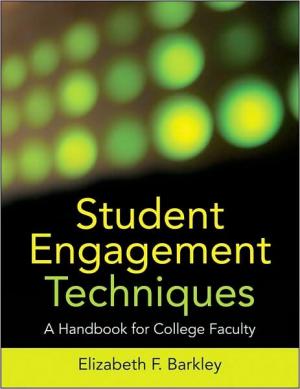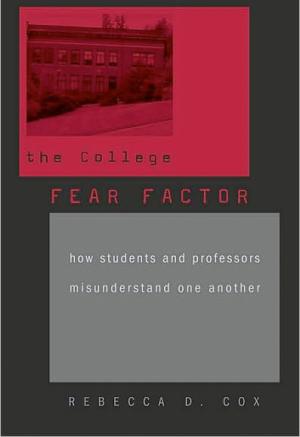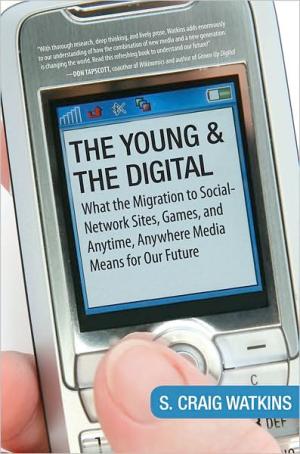Resources

Keeping students involved, motivated, and actively learning is challenging educators across the country,yet good advice on how to accomplish this has not been readily available. Student Engagement Techniques is a comprehensive resource that offers college teachers a dynamic model for engaging students and includes over one hundred tips, strategies, and techniques that have been proven to help teachers from a wide variety of disciplines and institutions motivate and connect with their students. The ready-to-use format shows how to apply each of the book's techniques in the classroom and includes purpose, preparation, procedures, examples, online implementation, variations and extensions, observations and advice, and key resources. "Given the current and welcome surge of interest in improving student learning and success, this guide is a timely and important tool, sharply focused on practical strategies that can really matter." Kay McClenney, director, Center for Community College Student Engagement, Community College Leadership Program, the University of Texas at Austin "This book is a 'must' for every new faculty orientation program; it not only emphasizes the importance of concentrating on what students learn but provides clear steps to prepare and execute an engagement technique. Faculty looking for ideas to heighten student engagement in their courses will find usefultechniques that can be adopted, adapted, extended, or modified."Bob Smallwood, cocreator of CLASSE (Classroom Survey of Student Engagement) and assistant to the provost for assessment, Office of Institutional Effectiveness, University of Alabama "Elizabeth Barkley'sencyclopedia of active learning techniques (here called SETs) combines both a solid discussion of the research on learning that supports the concept of engagement and real-life examples of these approaches to teaching in action." James Rhem, executive editor, The National Teaching & Learning Forum (From the Publisher)

They’re not the students strolling across the bucolic liberal arts campuses where their grandfathers played football. They are first-generation college students—children of immigrants and blue-collar workers—who know that their hopes for success hinge on a degree. But college is expensive, unfamiliar, and intimidating. Inexperienced students expect tough classes and demanding, remote faculty. They may not know what an assignment means, what a score indicates, or that a single grade is not a definitive measure of ability. And they certainly don’t feel entitled to be there. They do not presume success, and if they have a problem, they don’t expect to receive help or even a second chance. Rebecca D. Cox draws on five years of interviews and observations at community colleges. She shows how students and their instructors misunderstand and ultimately fail one another, despite good intentions. Most memorably, she describes how easily students can feel defeated—by their real-world responsibilities and by the demands of college—and come to conclude that they just don’t belong there after all. Eye-opening even for experienced faculty and administrators, The College Fear Factor reveals how the traditional college culture can actually pose obstacles to students’ success, and suggests strategies for effectively explaining academic expectations. (From the Publisher)
A 1000 word essay on using textbooks in introductory courses (or not).
A 1000 word essay on using textbooks in introductory courses (or not).
I have been experimenting with using role-playing and games in my religion classes for several years and have found that students respond well to these pedagogical tools and methods. After reviewing my experiences, I explore the reasons for students' positive response. I argue that role-playing games capitalize on our students' educational expectations and fondness for game-play, by drawing them into exploring significant texts and ideas. Of particular interest for religion and theology professors, these sorts of games also encourage empathy towards other viewpoints.
This essay asks: What are the ethics of engaging self-identified "conservative" students in topics and processes of learning that may unravel their world-view and possibly their personal lives? We should take their concerns, fear, and distrust seriously and not simply dismiss them as ignorant. We should strive to be "trustworthy" educators, guiding students through the consequences of transformative education. This paper argues that conservative students are critically examining and reacting to the liberal academy by leveling critiques similar to those found within feminist, post-colonial and post modern pedagogies. This essay reviews contemporary postmodern, postcolonial, and feminist pedagogies, which analyze bias and power in the classroom and have sought to represent marginalized voices in the classroom in order to challenge the way education often simply serves and protects the interests of the privileged. Pedagogies centered on subject or disciplinary method cannot secure a trustworthy pedagogy since method, thinking skills, and subjects are themselves bias-laden. But critical pedagogy offers insights to help us achieve the goal of becoming trustworthy educators for students coming from a wide spectrum of religious perspectives.
White and African-American students in the American South are able to meet and learn from Confucianism on its own terms much more readily than their peers elsewhere. This is because of their tendency to respect authority, participate in intergenerational ritual performances (especially those concerned with manners, meals, and mortuary practices), and judge the present in terms of the past (especially the U.S. Civil War). This is true despite the incompatibility that many southern students sense between Confucianism and their own religious doctrines. Instead, southern students' grasp of Confucianism rests on the grounds of lived religious experience. When southern students learn to see in Confucianism a set of beliefs, practices, and experiences that, in some ways, mirror their own, they are empowered to identify the tradition as "religious" in a way that renders "religion" a descriptive category of comparison rather than a limiting category of unique identity.
This essay discusses an approach to teaching religious studies in a general education or core curriculum that I have experimented with for the last decade, which I call the "Learning Covenant." The Learning Covenant brings together various pedagogical theories, including transformational, experiential, contract, and cooperative learning, in an attempt to address diverse learning styles, multiple intelligences, and student learning assessment. It has advantages over more traditional teacher-directed approaches to teaching, including meeting student resistance to "required" courses head-on by inviting them to identify learning needs regardless of chosen vocation and meeting them in the context of a religious studies course, recognizing the multiple ways in which students learn and providing a variety of opportunities for students to express their learning, and allowing students opportunity to take increased responsibility for their own learning. The essay will focus on the Learning Covenant's development, components, strengths, and drawbacks.
A Grinnell College (Iowa) study investigated whether students (n=200) felt that balanced discussion of racial/diversity issues was possible and why they did or did not want to discuss the issues. Most thought balanced discussion was impossible, feared a single viewpoint would dominate, and feared reprisal for speaking against the dominant perspective. Further findings and implications are discussed.

A media expert explains how and why the digital migration is transforming youth culture, identity, and everyday life
 
For the first time in over fifty years, television is no longer our dominant medium: young people are now spending an average of six to eight hours a day online. Watkins contends that most teens and twenty-somethings migrate online to share their lives with friends—something television simply cannot offer—and the ubiquitous presence of cell phones, laptops, and iPods places them at the center of our evolving digital landscape.